Four Days In Istanbul: Searching For The Glory Of The Past in Modern Türkiye
categories: europe travelA Long-Awaited Journey to Istanbul
Despite my long-standing fascination with the Eastern Roman Empire and the stunning architecture of Constantinople, it’s surprising that I never made it to Istanbul in the last five decades. However, in the spring of 2024, my wife and I finally took the chance to spend four days in Istanbul with some close friends. This captivating city welcomed us with its vibrant energy and had everything a travel enthusiast could wish for: a rich history, unique architecture, delicious cuisine, bustling markets, and countless surprises waiting to be uncovered.

Each member of our group had their own interests to explore in Istanbul. Personally, I was thrilled to see the remnants of Byzantium. One of our companions was keen on visiting various mosques, while another was fascinated by the Turkish food scene. Meanwhile, my wife was excited about the prospect of some exotic shopping and immersing herself in the modern culture of Turkey.
During our four-day stay, we visited many of the main attractions and made some delightful discoveries. Istanbul may not have been flawless, but it left a lasting impression on us.
Table of contents: ()
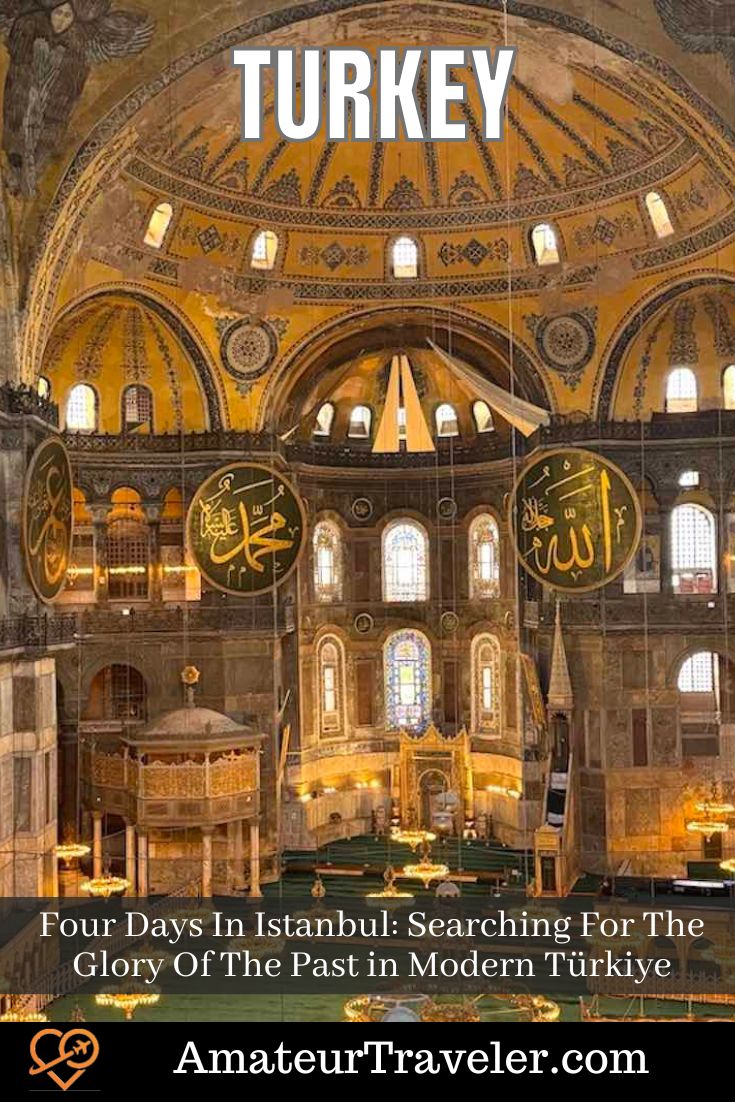
Istanbul’s Historical and Geographical Significance
Istanbul, situated in the present-day Republic of Türkiye (formerly known as Turkey), is the largest city in the region due to its unique geographical position straddling Europe and Asia. The Bosphorus Strait acts as the dividing line between the two continents. The western part of Istanbul, known as the Old City, is strategically situated on a small cape called the Golden Horn.
Originally named Byzantium and later Constantinople, the city traces its origins back to a Greek settlement. It went on to become the capital of the Eastern Roman Empire for more than 1100 years. Istanbul’s rich history encompasses ancient Greece, Rome, Christianity, the Ottoman Empire, and extends to the present day with modern Türkiye.
Arriving in Istanbul
During our trip to Istanbul, we took part in personal sightseeing as well as participated in guided group tours. Following a 10-hour flight from New York City, my wife, two close friends, and I arrived in Istanbul and stayed for three nights in the Taksim area located north of the Golden Horn. This location provided us with an ideal starting point, allowing us to acclimate to the time zone difference and immerse ourselves in the contemporary lifestyle of the city’s inhabitants.
We dined at exceptional restaurants and relished the breathtaking views of the Bosphorus, the strait connecting the Sea of Marmara to the Black Sea. Our accommodation was conveniently located near Taksim Square, where the Republic Monument stands as a tribute to the establishment of the Republic of Türkiye. This vibrant district boasted an array of dining establishments, shops, and hotels, bustling with locals going about their daily routines.
On our initial night, we discovered a charming eatery named Demite Meyhanesi (Demite Tavern). This cozy little place was adorned with antique furnishings and had a splendid balcony overlooking the Bosphorus. We were treated to a delightful menu featuring authentic Turkish mezes, main courses, and desserts. The homemade baklava was simply unforgettable.
Day One
On our second day, we were eager to explore the city, so we opted to take a stroll. Istanbul is undeniably a city that is best discovered by walking.
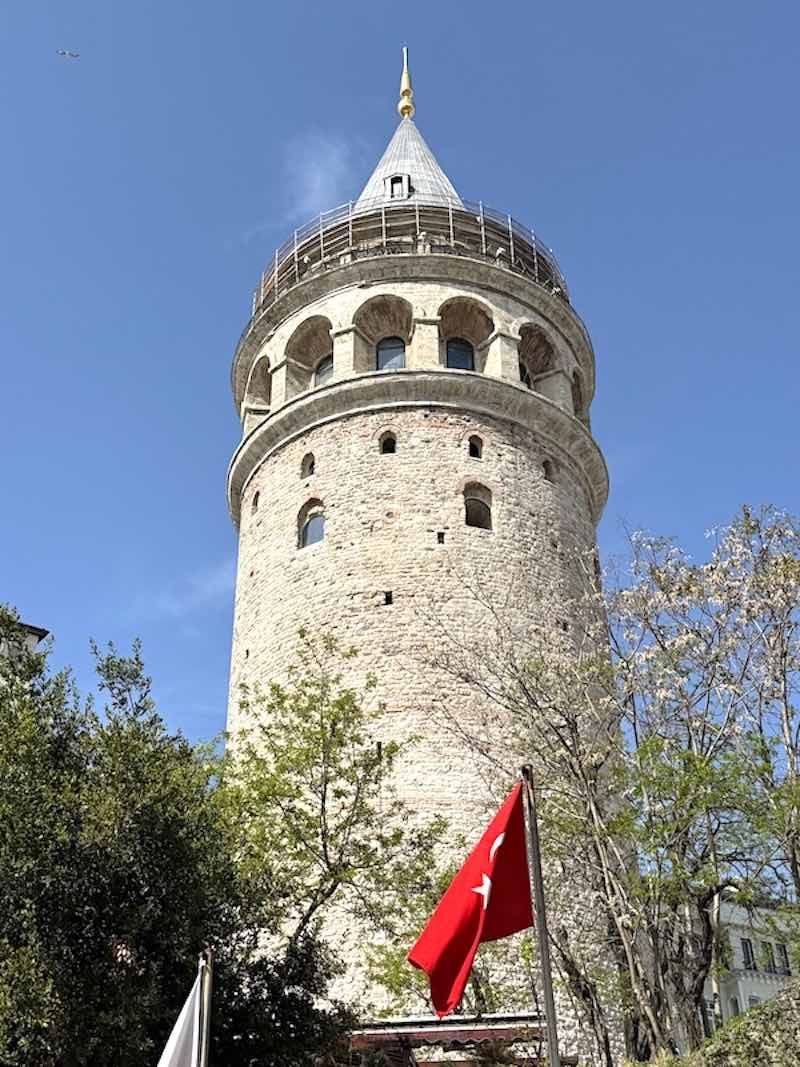
The Galata Tower overlooking the Golden Horn
Galata Tower
Wandering through the narrow, meandering streets allowed us to observe the hustle and bustle of the city and witness the daily routines of Istanbul’s residents. As Taksim Square is situated atop a hill, we planned a route that led us downhill towards the Golden Horn and the Old City. Our initial stop was the iconic Galata Tower, an ancient Genoese tower renowned for its position at the highest point on the former Walls of Galata, offering panoramic views of the Golden Horn and Old City.
Although the tower currently functions as a museum, its main attraction lies in its breathtaking vistas. Regrettably, the tower was closed for renovations that were scheduled to be completed before our visit but were still ongoing. Undeterred, we continued our journey towards the Old City.
Each member of our group expressed a desire to visit a mosque, so we proceeded to the Blue Mosque, only to discover that it too was closed for renovations. Despite this second disappointment, we remained determined to explore and experience the beauty of Istanbul.
The Basilica Cistern
Thankfully, our next destination was open and had a relatively brief entrance line. The Basilica Cistern, constructed in the 6th century, was the largest among a series of ancient underground cisterns built beneath the city of Constantinople. Its name originated from being built beneath a former basilica that was transformed into a large public square known as the Basilica Stoa.
The present cistern is expansive and has been renovated to allow access for tourists. Supported by 336 marble columns, each 30 feet tall, arranged in 12 rows of 28 columns spaced 16 feet apart, the cistern creates a mesmerizing effect for visitors as the water level is kept low and pathways were constructed to give the impression of walking through a forest of columns. Adding to the allure, the interior was illuminated with colored lights that continuously changed to create various scenic effects.
Different capitals adorned different columns, likely salvaged from other structures during the cistern’s construction. Additionally, two bases with carved Medusa heads added to the intrigue. The cistern proved to be a remarkable and distinctive site well deserving of a visit.
We spent a considerable amount of time there learning about the history of the underground cisterns and admiring the rows of columns supporting the structure. We captured numerous photographs and relished the unique experience.
Dining with a View
Following our visit, we enjoyed a meal at the Seven Hills Restaurant in Sultanahmet. Conveniently positioned between the Hagia Sophia and the Blue Mosque, the restaurant offered both indoor and outdoor rooftop seating options. The menu featured a wide array of fish and traditional Turkish dishes, but the real highlight was the breathtaking view, offering unparalleled opportunities to capture stunning photographs of the mosques and the Bosphorus.
Additionally, the restaurant provided a perfect setting to listen to the synchronized call to prayer at noon, harmoniously chanted by the muezzins from both the Hagia Sophia and Blue Mosque.
The Hippodrome
The reverberating recitations between the two mosques created a truly unforgettable experience that every visitor to Istanbul should witness. After a relaxing lunch and capturing numerous photographs, we proceeded to the park located on the grounds of the former Hippodrome, a renowned ancient stadium used for chariot races. Although the stadium itself has mostly disappeared, a few monuments still remain, preserving the overall layout and atmosphere of the original space. I had an enjoyable conversation with the owner of a restaurant along the Hippodrome, who amusingly tried to convince me to dine at his establishment by claiming that his great-grandfather contributed to the construction of the ancient Walled Obelisk.
The Grand Bazaar
After spending some time in the Hippodrome area, we decided to explore the hilly and winding streets of the Old Town on foot. Eventually, we stumbled upon one of the entrances to the Grand Bazaar. We were amazed as we gazed at the seemingly endless rows of aisles and stalls, numbering somewhere between 4 and 5 thousand. As a husband, I made a significant mistake when I discouraged my wife from buying a clothing item due to its perceived expense. My error was a result of miscalculating the conversion rate.
Fortunately, I was able to correct my mistake by returning ten days later and successfully navigating to the shop to finally make the purchase. Outside the Grand Bazaar, we also had the opportunity to see the Column of Constantine, one of the few remnants of Byzantium.
Our evening ended at another remarkable restaurant in Taksim called Ficcin, which was popular among both locals and tourists. The restaurant offered plenty of outdoor street-side dining and featured traditional Turkish dishes. Once again, we savored the variety of mezes, a meat pie, fish dishes, and main courses.
After our meal, we made a stop at a Turkish ice cream shop to witness the must-see performance by the vendors, who used various tricks to serve me and make my ice cream mysteriously disappear.
All in all, we had a fulfilling day in Istanbul and thoroughly enjoyed our explorations.
Day Two
Our following day revolved around a group excursion that encompassed visits to the Hagia Sophia, the Topkapı Palace, the Hippodrome, and the Spice Market. Originally, the Blue Mosque was included in our plans, but due to its closure, we visited a smaller mosque instead.
We were eager for the day ahead, although we were aware that it would entail larger crowds and a more rigid schedule compared to our previous days. We made sure to arrive early to queue up for the Hagia Sophia before the arrival of cruise ship passengers and student groups. This proved to be a wise decision.
Hagia Sophia
I had been eagerly anticipating this visit ever since we first booked our trip to Turkey. The Hagia Sophia started as a church, was converted into a mosque, then transformed into a museum, and most recently reverted back to a mosque. Over time, it has evolved into one of the most remarkable examples of art and architecture blending Christian and Muslim influences.
The name “Hagia Sophia” translates to “Saint Sophia,” with Sophia representing wisdom in Greek rather than a specific individual. The structure we explored was ordered by Emperor Justinian and represented the third version of the Church of Holy Wisdom constructed at this location. It was consecrated on December 27, 537, an astonishing accomplishment considering it was completed just five years after construction began.
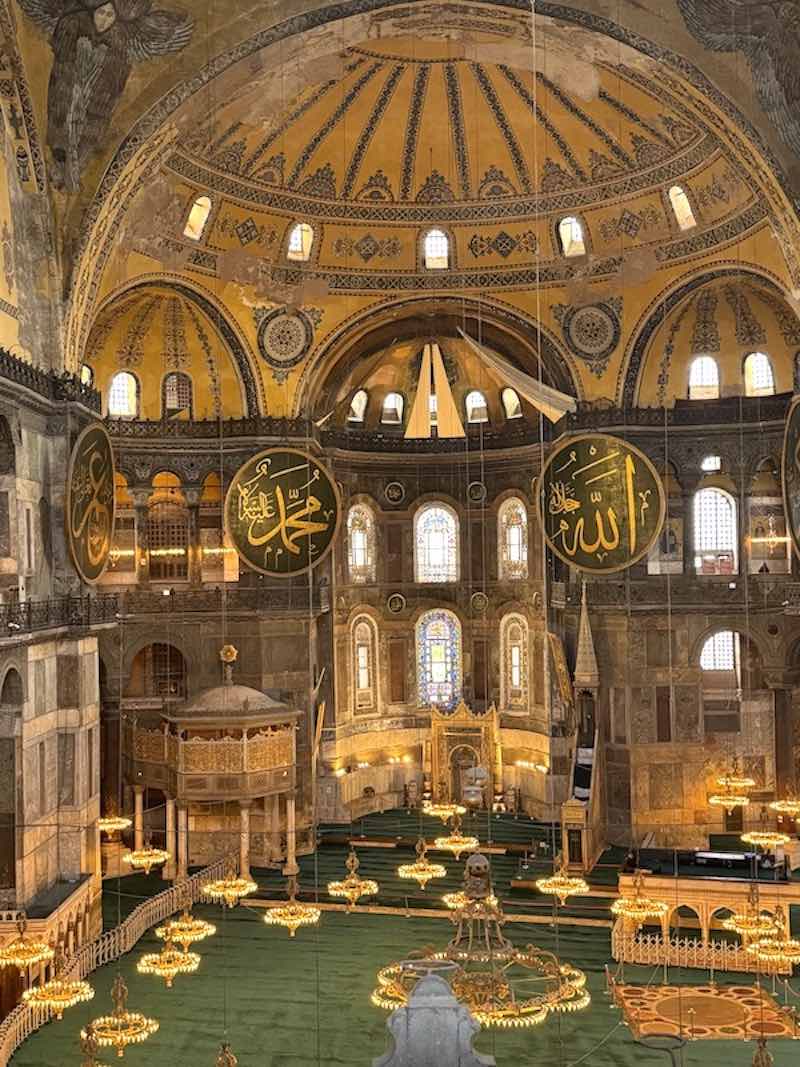
The interior of the Hagia Sophia looking toward the central apse
The Hagia Sophia served as the seat of the Orthodox patriarch of Constantinople and hosted significant Byzantine ceremonies, including emperor coronations. In 1453, Sultan Mehmed II of the Ottoman Turk Empire conquered Constantinople and converted the Hagia Sophia into a mosque, renaming it Aya Sofya. Nearly all Christian elements were removed or covered, while new Islamic features such as floral and calligraphic designs, a mihrab, a minbar, and four minarets were added.
It remained the primary mosque of Istanbul until 1931 when it was shut down, only to reopen as a museum in 1935. Our tour led us to the second level of the building to observe the main floor and various mosaics. It became apparent to me that the viewpoints were not optimal for tourists.
The structure was converted back into a functioning mosque a few years ago, rather than remaining a museum. While all visitors are welcomed, they have been confined to the second floor. The views were acceptable but did not allow us to fully appreciate the magnificence of the structure.
The ground floor was designated solely for worshippers. I must confess, I was underwhelmed. The experience felt darker and less dramatic than I had anticipated.
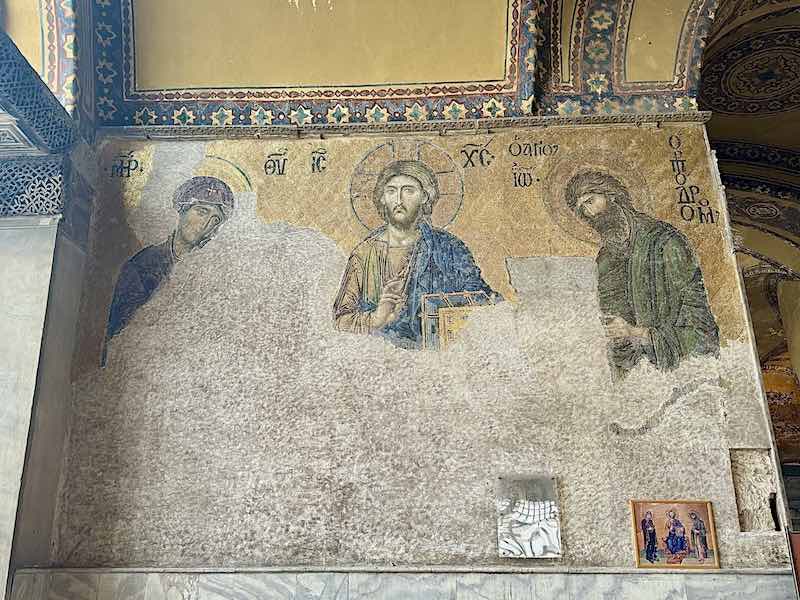
The Deësis mosaic featuring Mary, Jesus, and John the Baptist
I was grateful for the chance to explore the Hagia Sophia, yet I couldn’t shake the feeling that our visit fell short of its potential. Some of the highlights of my visit included the mosaics on the second floor, such as the Deesis Mosaic, portraying Jesus Christ with the Virgin Mary and John the Baptist.
Additionally, there was a remarkably well-preserved mosaic at the bottom of the exit staircase known as the Chamber of the Warriors, featuring Mary holding the Christ child, Constantine, and Justinian I.
[Editor: There are also private tours of Hagia Sofia that allow you to skip the line.]
Topkapı Palace
Upon exiting the Hagia Sophia, our group queued up to enter the Topkapı Palace through the Imperial Gate. The Topkapı Palace, also referred to as the Seraglio, was the central administrative center of the Ottoman Empire and the main residence for ruling sultans from its establishment around 1460 until the construction of the Dolmabahçe Palace in 1856. Sultan Mehmed the Conqueror initiated the construction in 1459, just six years after the conquest of Constantinople.
Positioned on the Seraglio Point, a strategically advantageous promontory with a view of the Golden Horn where the Bosphorus Strait meets the Marmara Sea, the palace complex is built on a hilly terrain, with the palace itself located at one of the highest points near the sea. As time passed, the complex grew in size, and today consists of four main courtyards surrounded by multiple structures. Its importance gradually waned after the 17th century.
- Get a universal plug adapter
- Search for Great Tours HERE
- Book Your Accommodation HERE
- Buy Travel Insurance
- Get an eSim to be able to use your smartphone abroad.
- Get a Car Rental

After the dissolution of the Ottoman Empire in 1923, the Topkapı complex was transformed into a museum through a government decree issued on April 3, 1924. Our tour led us through numerous sections, providing us with extensive knowledge about the palace’s history and its former occupants. We explored key locations including the kitchens, various ceremonial rooms, the Imperial Council Chambers, the Library of Sultan Ahmet III, the privy chamber, a harem, and different audience halls.
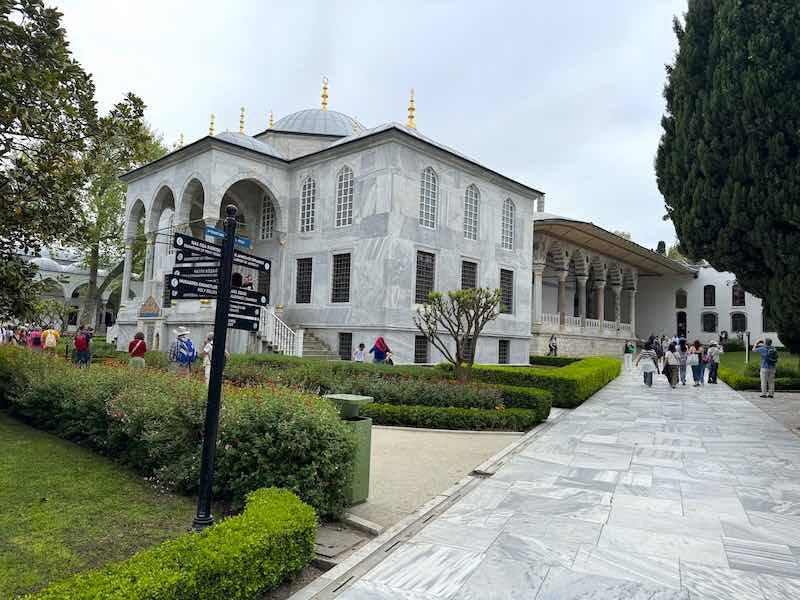
The Library of Sultan Ahmet III in the Third Court of the Topkapi Palace
From the palace’s balconies, we enjoyed splendid views of the Bosphorus and the Golden Horn. The tour concluded with a visit to the Imperial Treasury museum, where we admired arms, armor, gemstones, and sacred relics like the Topkapı Dagger, Kaşıkçı Diamond, the Prophet David’s sword, the staff of the Prophet Moses, and a footprint of the Prophet Muhammad.
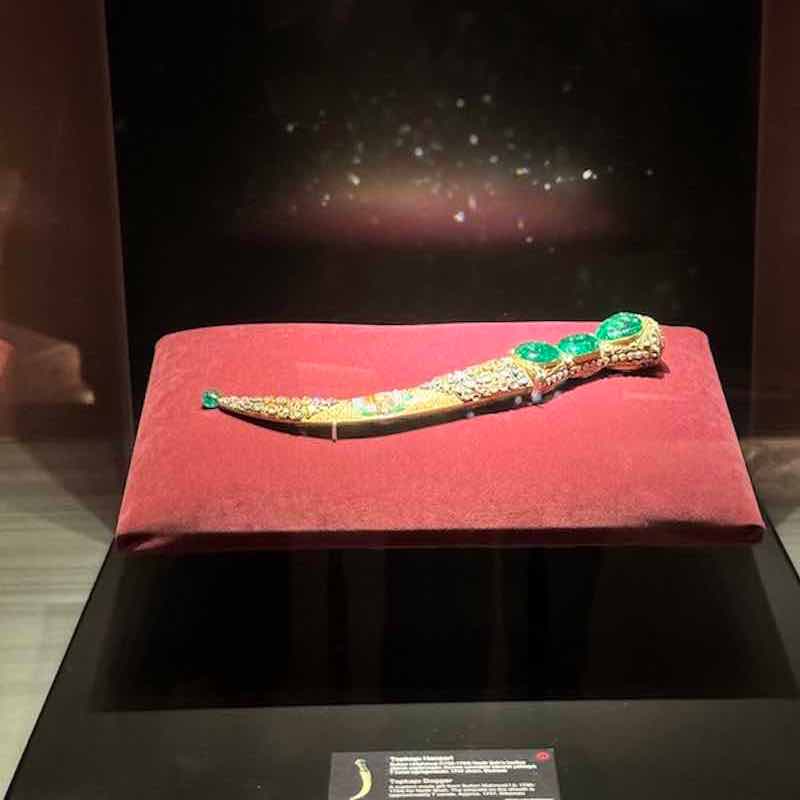
The Topkapi Dagger in the Imperial Treasury Museum of the Topkapi Palace
Despite the short wait line to get in, the museum exhibit halls were overcrowded with tour and school groups by the time we arrived. The cramped hallways and viewing areas made it challenging to appreciate the artifacts due to much pushing and shoving.
Following the museum visit, we were eager for a lunch break. After a satisfying Turkish lunch near Sultanahmet Park, situated between the Hagia Sophia and the Blue Mosque, we embarked on a guided tour of the Hippodrome section in Sultanahmet Square.

The Hippodrome featuring the Serpent Column and the Ancient Egyptian Obelisk of Theodosius
The Hippodrome
This allowed us to view the few remaining artifacts that once graced this historic site. The Hippodrome of Constantinople, similar to Rome’s Circus Maximus, served as both a sporting arena and a social hub for the city. This U-shaped stadium had the capacity to accommodate approximately 100,000 spectators and was regularly renovated by emperors to showcase the opulence of the Empire.
Unfortunately, after the Fourth Crusade’s pillaging of Constantinople, the Hippodrome gradually fell into disrepair, and numerous valuable treasures were relocated to other cities. Presently, the remnants fail to capture the former magnificence of the arena. Nonetheless, it was a pleasure to delve into the history of three artifacts that still grace the area: the Serpent Column, the Obelisk of Theodosius, and the Walled Obelisk.
The Spice Bazaar
We proceeded to visit the Spice Bazaar and a small mosque that featured interior tiling resembling that of the Blue Mosque. These attractions were situated in close proximity to the northern area of the Golden Horn, near the Galata Bridge.
The Spice Bazaar, being the second largest covered shopping complex after the Grand Bazaar, bore many similarities to its larger counterpart. The bazaar was a component of the New Mosque complex, and the revenue generated from the rented shops within the bazaar contributed to the maintenance of the New Mosque in Istanbul.
This was the ideal location to indulge in the famous local sweet appropriately named Turkish Delight and sample a variety of teas crafted from different spice blends. With numerous shops offering sweets, spices, and teas, it proved to be quite a challenge to determine which ones were the finest. It was a great place to make deals and find special treats from Istanbul to bring back home for family and friends.
Day Three
Ten days later, we made our way back to Istanbul and stayed at the Legacy Ottoman Hotel, which was conveniently located near the Spice Bazaar.
Bosphorus Cruise
With only a day and a half left, we decided to make the most of it by embarking on a cruise along the Bosphorus, exploring the fish market, and returning to the Grand Bazaar for some shopping. There were various Bosphorus cruises available at different times of the day. The nighttime cruises offered not only breathtaking views but also meals and entertainment, while the daytime cruises focused more on the sights along the Bosphorus.

The Rumeli Fortress as seen from the Bosphorus
We opted for a two-hour afternoon cruise, which primarily covered the area from the Golden Horn to the Fatih Sultan Mehmet Bridge. During our cruise, we passed under the July 15th Martyr’s Bridge, connecting both continents, and headed north towards the Fatih Sultan Mehmet Bridge. Along the way, we caught glimpses of notable landmarks such as the Rumeli Fortress, Maiden’s Tower, Galata Tower, and Ortakoy Mosque.
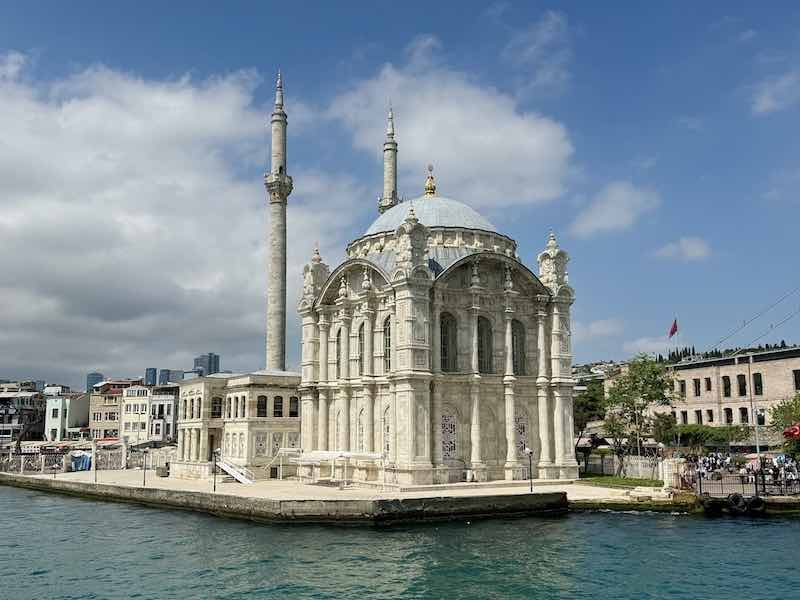
The Grand Mecidiye Mosque (Ortaköy Mosque) as seen from the Bosphorus
The journey was highlighted by a continuous display of magnificent homes, mansions, and palaces, leaving us in awe. It made me wonder how splendid it would be to reside along the Bosphorus and wake up to such a captivating waterway every day.
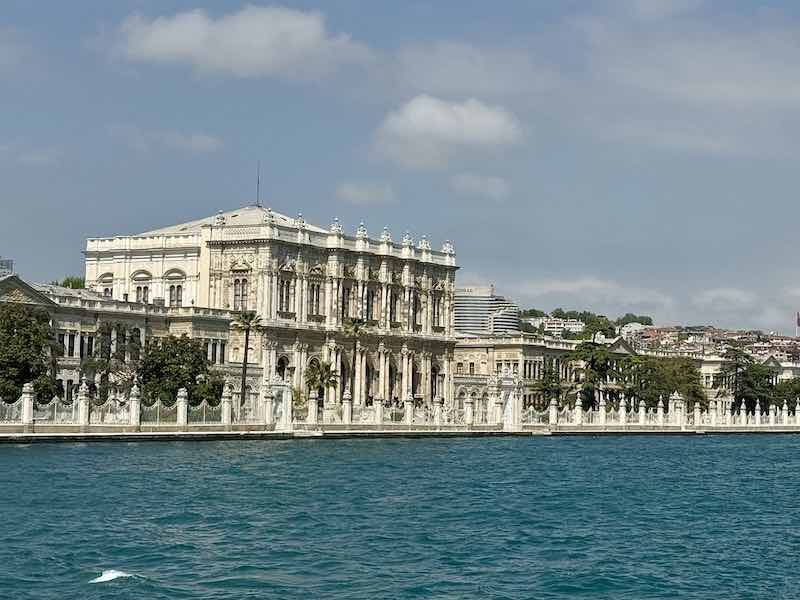
The Dolmabahce Palace constructed between 1843 and 1856 by Sultan Abdulmejid I
Undoubtedly, the highlight of our cruise was the Dolmabahce Palace, an architectural marvel constructed between 1843 and 1856 by Sultan Abdulmejid I. This magnificent palace had been home to six different Sultans until the abolition of the Caliphate in 1924.

Three small boats offering Bal¹k ekmek sandwiches at the Golden Horn Bridge
As our cruise neared its end, we found ourselves near the Galata Bridge, where the Golden Horn meets the Sea of Marmara. Here, we encountered three small boats, offering Balık ekmek sandwiches – fish filets grilled or fried and served with salad in baguette-style bread. Patrons eagerly attempted to purchase their sandwiches while the boats bobbed up and down. The area provided a unique backdrop for photographs and left a lasting impression with its distinct aroma of fish.
Final Visit to the Bazaar
After we visited the fish market, we made our way back to the Grand Bazaar. It was here that we finally managed to find the piece of clothing for my wife that we had not purchased during our earlier trip to Istanbul.
Our final visit to the bazaar presented a perfect chance for us to spend our remaining Turkish Lira on purchasing gifts and souvenirs for our loved ones. Engaging in the art of bargaining, we tried our best to obtain our souvenirs at a fair price. As expected, the bazaar was bustling with tourists and shoppers, all seeking mementos of their time in Istanbul.
Day Four
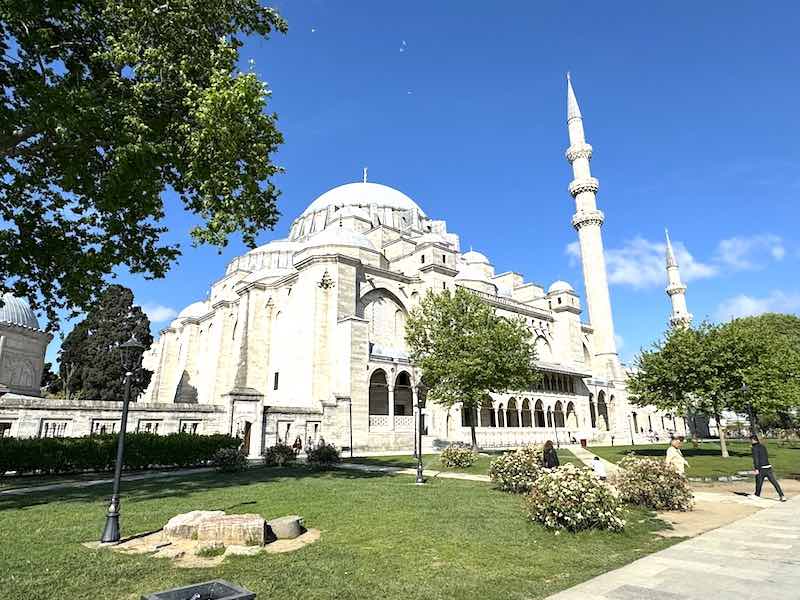
The Suleymaniye Mosque completed in the year 1557 and designed by the renowned architect Mimar Sinan
Suleymaniye Mosque
Our exploration of Istanbul was not yet complete, as we had intentionally saved a hidden gem to visit on our final day before our evening flight back to the United States. Rising early, we indulged in a hearty breakfast and embarked on a journey up the third hill of the Golden Horn, leading us to the majestic Suleymaniye Mosque, a masterpiece completed in the year 1557. In many aspects, we had indeed saved the best for last.
The breathtaking views from the mosque and the overall experience surpassed our expectations of Istanbul. This architectural marvel, commissioned by Sultan Suleiman the Magnificent and meticulously designed by the renowned architect Mimar Sinan, truly embodied the grandeur of the Ottoman Empire. The courtyard of the mosque was adorned with four minarets, enclosing a central fountain that added to its allure.
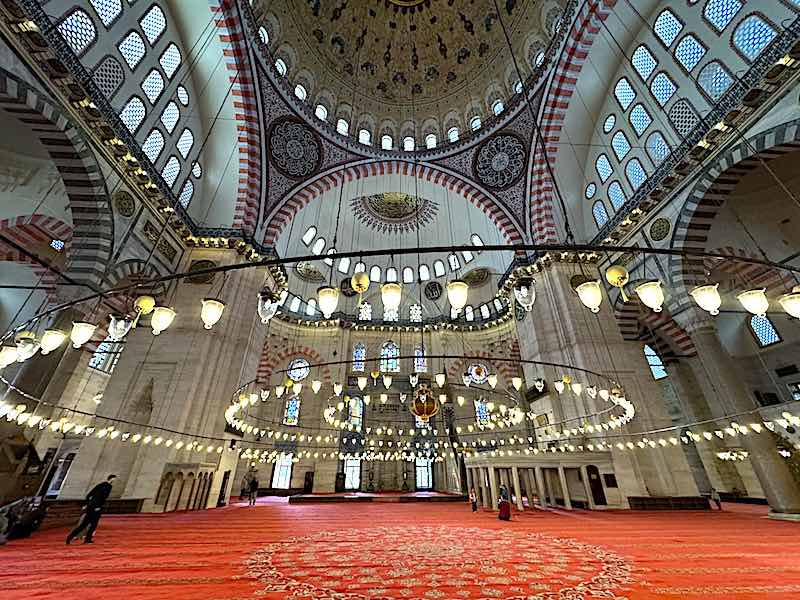
The grand interior of the Suleymaniye Mosque
While visitors entered through the front entrance, worshippers had a separate side entrance dedicated to their use. Upon entering the mosque, it was customary for us to remove our shoes and for women to cover their hair, as is the practice in any functioning mosque. We were granted the privilege of staying inside and capturing photographs for as long as we desired. To facilitate better lighting for photographers, the interior mosque lights were periodically switched on.

The mausoleum of Suleiman the Magnificent adjacent to the Suleymaniye Mosque
Adjacent to the main mosque, there was an enclosed cemetery housing the separate mausoleums of Sultan Suleiman I and his wife Hürrem Sultan (Roxelana). The mausoleum of Suleiman the Magnificent also contained the tombs of his daughter Mihrimah Sultan, as well as those of two later sultans: Suleiman II and Ahmed II.
Farewell to Istanbul
This experience served as a fitting conclusion to our exploration of Istanbul. We still had two hours, so we traversed the hills of the Golden Horn, eventually reaching the Tarihi Cesme Restaurant situated at the base of the Hippodrome walls in the Old City. There, we enjoyed a delectable lunch specializing in traditional Turkish cuisine and a variety of fish dishes.
Following our meal, we only had time to bid farewell to Istanbul and make our way to the airport. Istanbul proved to be an extraordinary city, encompassing all the elements I enjoy about travel. Its distinct culture, rich history, magnificent structures, unique architecture, lively culinary scene, and excellent shopping opportunities left me wanting more.

Ortaköy
Conclusion
Remnants of Byzantium
Surprisingly, I personally found it much more difficult to see the remnants of Byzantium than I expected. The city we experienced showcased more of its Ottoman history rather than its Byzantine Roman roots. While we did come across remnants of Byzantium, such as converted churches, medieval forts, and monuments like the Column of Constantine, they required some effort and imagination to envision in their original form.
Exploring Other Ancient Sites
Fortunately, we explored many remnants of the Greek and Roman Empires in Turkey when we also visited Ephesus, Pergamum, and Hierapolis during the same journey. Regrettably, we missed out on two sites in Istanbul that we hoped to visit: the late 4th-century Aqueduct of the Roman Emperor Valens and the renowned Theodosian Walls of Constantinople. These locations would have required additional travel and tours as they were situated quite a distance from the Golden Horn.
Planning for a Future Visit
Both will have to wait until our next visit. Despite encountering some disappointments, such as closed or restricted access to certain sites, our newfound discoveries far outweighed any negatives. If you haven’t yet experienced Istanbul, I highly recommend adding it to your list of must-see travel destinations.
Allocate ample time to explore the city and immerse yourself in its various neighborhoods. Istanbul offers an abundance of captivating sites to explore, effortlessly blending history, culture, and the vibrancy of urban life. Like any remarkable travel experience, I am eagerly awaiting my next visit!

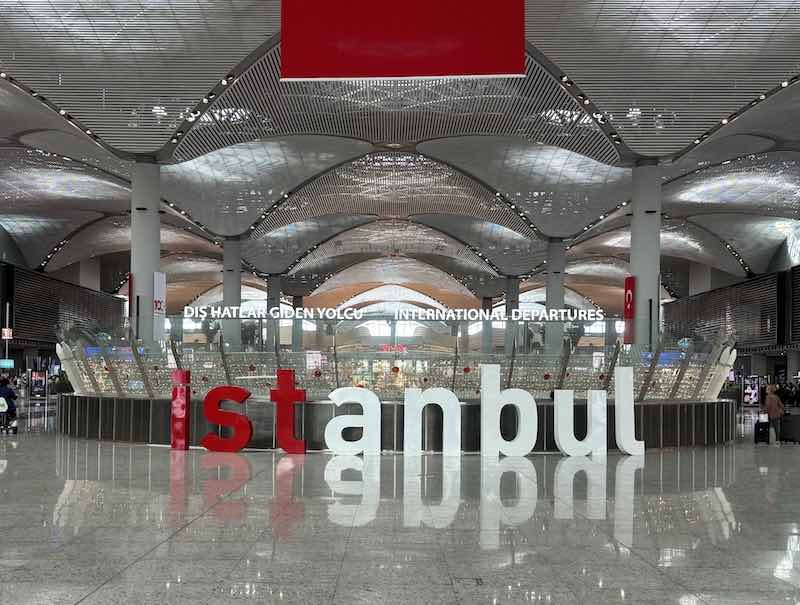
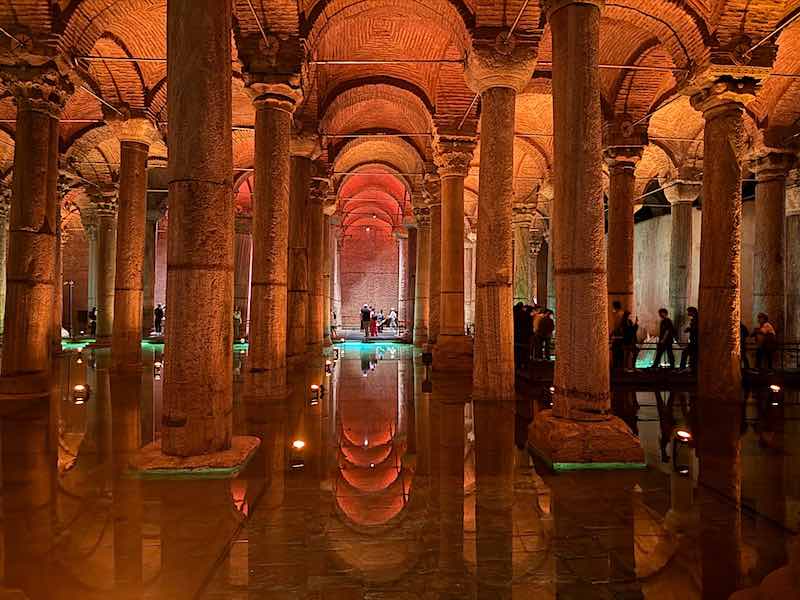
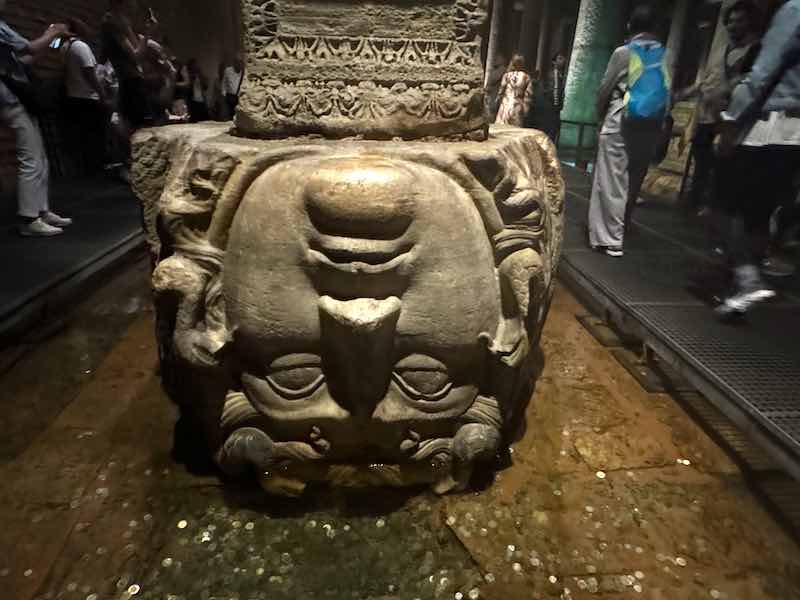

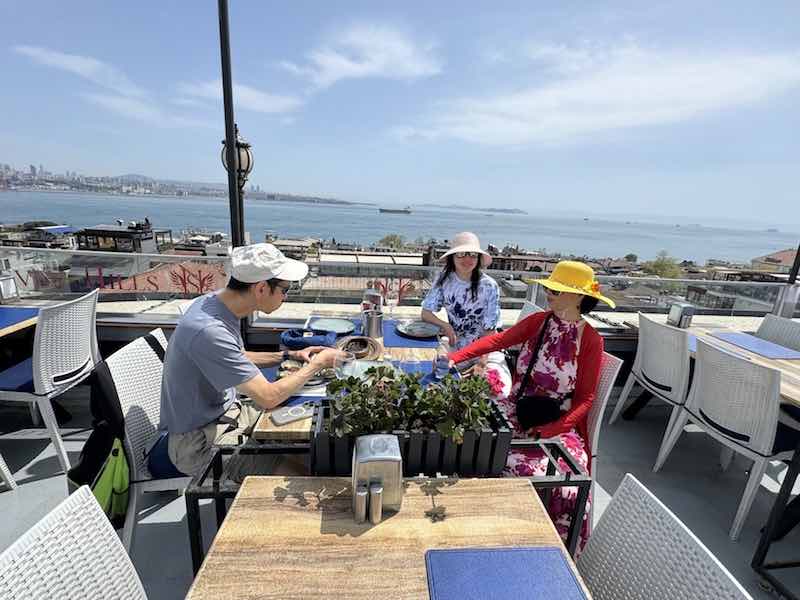


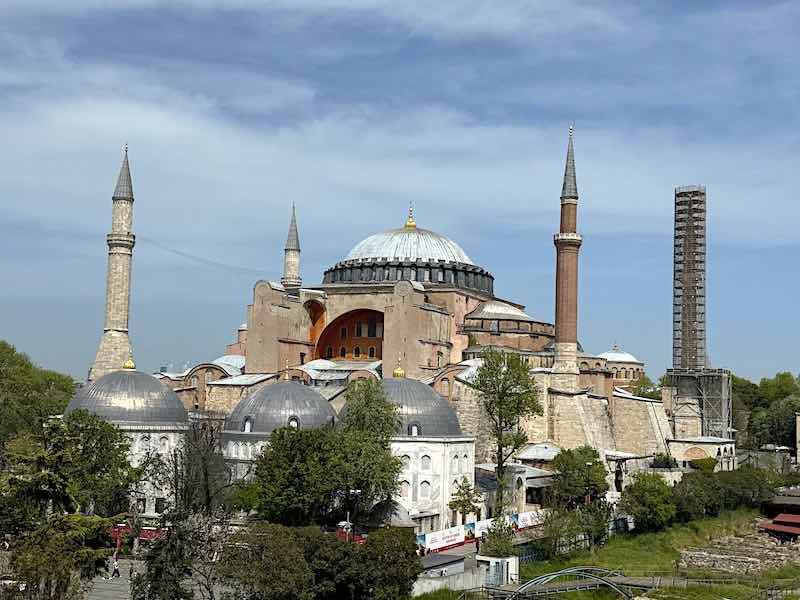
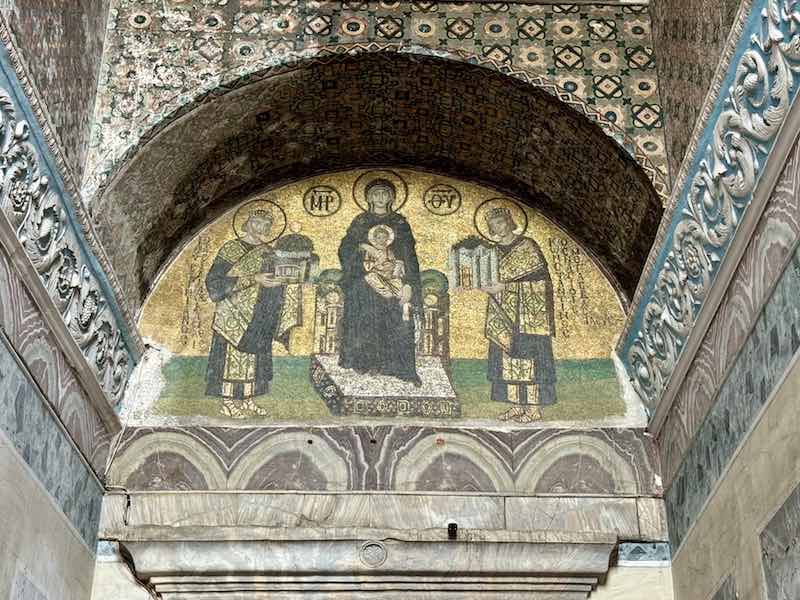




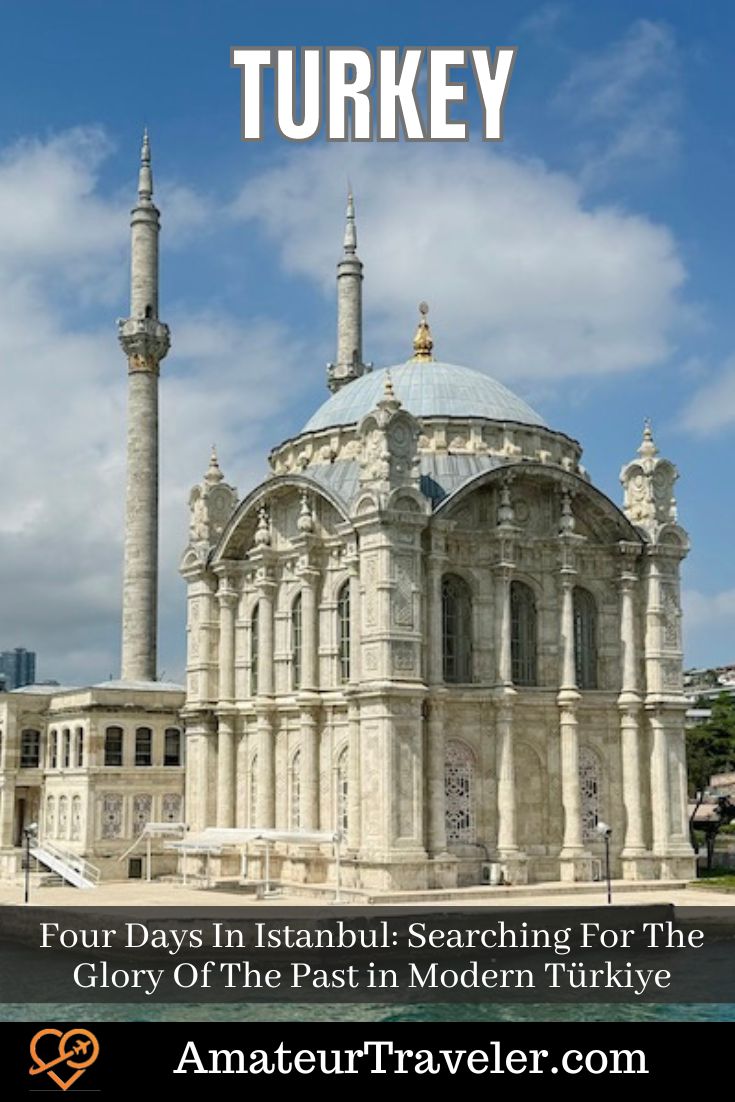
 3 Days in Istanbul, Turkey
3 Days in Istanbul, Turkey Turkey, Istanbul – Episode 83
Turkey, Istanbul – Episode 83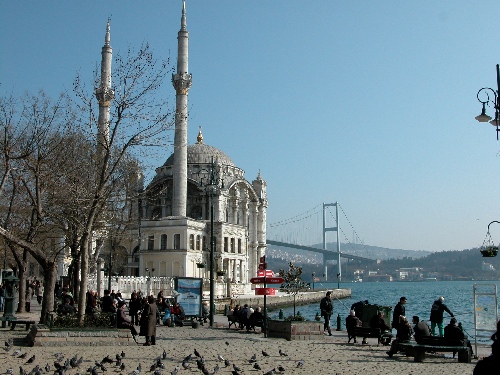 Istanbul on Travel in 10
Istanbul on Travel in 10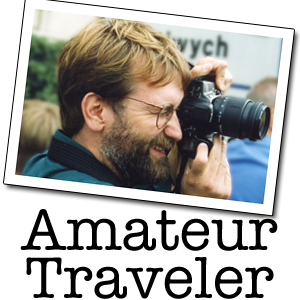 Istanbul, Turkey – Hagia Sophia – Video Episode 19
Istanbul, Turkey – Hagia Sophia – Video Episode 19
